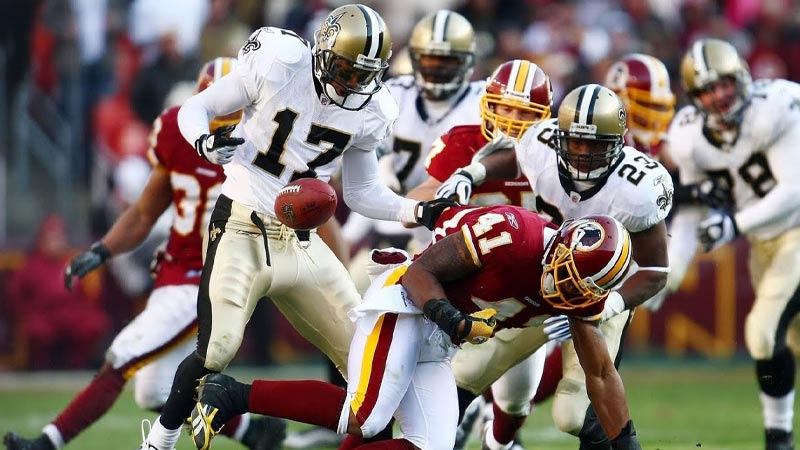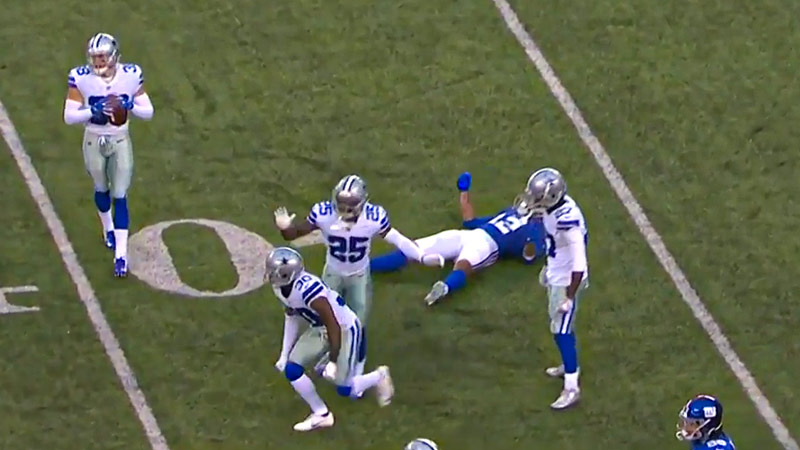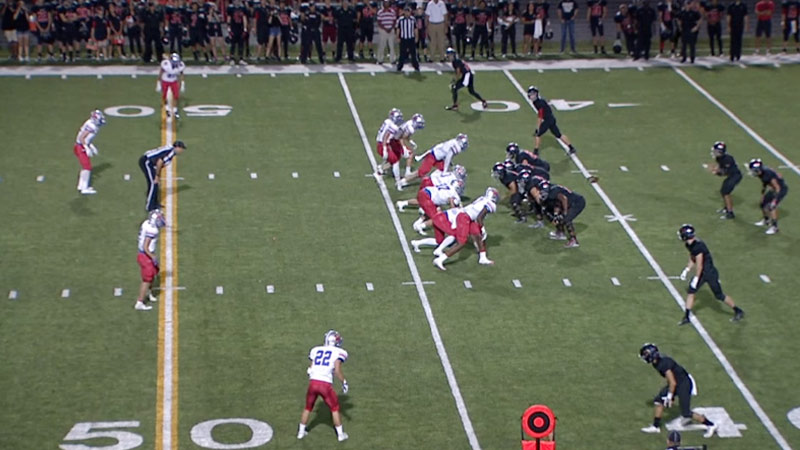Football is a game of strategy, precision, and moments that can change the course of an entire match. Among its many intricacies, the “Turnover on Down” rule stands as a critical juncture that can shape the momentum, tactics, and final outcome of a game.
Whether you’re a die-hard fan or a casual observer, grasping the nuances of this rule can deepen your appreciation for the sport.
In this comprehensive guide, we delve into the Turnover on Down rule, breaking down its significance, and its impact on the game, and answering common questions that often arise.
What Is Turnover on Downs in Football?
In American football, a turnover on downs refers to a pivotal situation when a team’s offensive unit exhausts its allotted downs – usually four in American football – without gaining the required yardage for a new set of downs.
This inability to advance down the field results in the forfeiture of possession to the opposing defensive team. The offensive team’s failure to achieve a first down within their allocated downs can stem from a variety of factors, including unsuccessful passing or running plays.
Turnovers on downs often occur in critical areas of the field, influencing game momentum and strategic decisions. This turnover grants the defensive team immediate control of the ball and field position, providing them an opportunity to capitalize on their opponent’s offensive inefficiency.
When Does Turnover Happen in Downs?
A turnover on downs occurs in gridiron football when the offensive team uses all of their allotted downs (typically four in American football) but fails to advance the necessary distance to achieve a first down.
In American football, a team is required to advance the ball at least 10 yards within their four downs to earn a new set of downs.
If the offensive team is unable to achieve this, the ball is turned over to the opposing defensive team at the spot where the last play concluded.
This change of possession provides the defensive team with an opportunity to take over the offensive role and attempt to advance the ball down the field in their possession.
What Happens When Turnover Occurs on Down?
When a turnover on downs occurs in gridiron football, it means that the offensive team has used all of their allotted downs (usually four) but has not gained enough yardage to earn a new set of downs.
As a result, possession of the ball is handed over to the opposing defensive team at the spot on the field where the last offensive play concluded.
The new offensive team, now playing defense, takes control of the ball from that spot and starts their possession. This turnover provides the defensive team with an advantageous field position, often closer to the opponent’s end zone.
They then have the opportunity to attempt to advance the ball and score points during their offensive possession.
How to Avoid Turnover on Down?

Avoiding a turnover on downs in gridiron football involves strategic decision-making and effective execution of various plays. Here’s an elaboration on the ways to avoid turnover on downs:
Punting
When an offensive team is nearing the end of their downs and feels they can’t make a first down or score a field goal, they may opt to punt the ball.
Punting involves kicking the ball deep into the opponent’s territory, sacrificing possession to gain a favorable field position.
This strategy is often employed when the team is far from scoring range and wants to pin the opposing team deep into their own territory.
Fake Punting
To add an element of surprise, a team might attempt a fake punt. This involves making the opposing team believe a punt is coming, but instead, executing a different offensive play to gain the necessary yardage.
It requires precise execution and can catch the defense off-guard, allowing the offense to continue their possession.
Field Goal
If an offensive team is close enough to the opponent’s end zone but not confident in making a first down, they can attempt a field goal. A successful field goal scores three points and avoids a turnover on downs.
However, this option is typically chosen when the distance to the goalposts is manageable.
Fake Field Goal
Similar to a fake punt, a fake field goal involves deceiving the opposing team by initially setting up for a field goal attempt and then executing a different play to either gain yards or score a touchdown.
It’s a high-risk, high-reward strategy that requires excellent timing and execution.
Scoring a Touchdown
If the offensive team is in a goal-to-go situation, aiming for a touchdown is a primary objective. Scoring six points not only avoids a turnover but also maximizes the points earned.
This approach is suitable when the team is close to the end zone and confident in their ability to score.
Getting First Down
The primary goal on offense is to move the ball ten yards down the field to earn a new set of downs.
This can be achieved through passing or running plays. Effective play-calling and execution are crucial to consistently make first downs and maintain possession.
Kicking
Kickoffs, onside kicks, and kickoff returns are also aspects of the game where a team can regain possession without facing a turnover on downs.
Successful onside kicks, though challenging, provide the kicking team a chance to maintain possession and continue their drive.
Avoiding a turnover on downs involves a mix of smart decision-making and execution of various offensive and special teams’ plays. Each option comes with its own set of risks and rewards, and the choice depends on the game situation, field position, and the team’s overall strategy.
Impact of Turnover on Down Rules in Football

The turnover-on-downs rule in football has a significant impact on the flow, strategy, and outcome of the game. Here’s how this rule influences the game:
Field Position Swing
A turnover on downs often results in a change of possession, leading to a shift in field position. The defensive team gains possession closer to their opponent’s end zone, putting them in a better position to launch an offensive drive and potentially score points.
Momentum Shift
Failing to convert on downs can swing the momentum of the game. The defensive team gains confidence and energy from stopping the offense’s progress, which can affect the psychological dynamics of both teams.
Strategic Decision-Making
Teams must carefully decide whether to go for it on fourth down or kick the ball away. The risk-reward analysis can lead to intriguing strategic choices, with teams considering factors like field position, score, time remaining, and their confidence in converting the required yardage.
Pressure on Defense
When the offensive team fails to convert on downs, the defense often faces immediate pressure to hold the opposing offense and prevent them from capitalizing on the turnover. This can showcase the resilience and adaptability of the defensive unit.
Scoreboard Impact
Turnovers on downs can have a direct impact on the scoreboard. If an offensive team fails to convert near their own end zone, it could lead to a short field for the opposing offense, potentially resulting in quick points.
Game Flow and Clock Management
A turnover on downs can affect how teams manage the game clock. The team that gains possession must decide whether to control the clock by running the ball or trying to score quickly.
Game Outcome
The ability to consistently convert on downs and avoid turnovers often plays a role in determining the outcome of the game.
Teams that effectively sustain drives and avoid turnovers on downs tend to have more opportunities to score and control the tempo of the game.
Showcasing Skill and Strategy
The turnover on downs rule highlights the strategic depth of football. Coaches must make informed decisions about when to attempt a fourth-down conversion, punt, or field goal. These decisions can define a team’s approach and effectiveness.
The turnover on downs rule is a fundamental aspect of football that shapes the game’s dynamics, strategy, and outcome.
It forces teams to balance risk and reward, influences field position, and can swing momentum in either direction.
The rule underscores the complexity and excitement of gridiron football by adding layers of decision-making and competition.
FAQs
What exactly is the Turnover on the Down rule?
The Turnover on Down rule comes into play when the offensive team exhausts its allotted downs without gaining the required yardage to achieve a new set of downs.
In American football, a team is typically given four downs to advance the ball 10 yards. Failure to do so results in a change of possession, with the opposing team gaining control of the ball from the spot of the last play.
How does the rule influence strategic decisions?
Strategic decision-making is at the heart of football, and the Turnover-on-Down rule amplifies its importance.
Coaches must evaluate factors like field position, time remaining, and the score differential when deciding whether to attempt a fourth-down conversion, kick a field goal, or punt the ball.
These decisions often hinge on the confidence in their team’s ability to convert the necessary yardage.
What impact does the rule have on momentum?
The Turnover on the Down rule can be a momentum-shifting moment. When an offensive team fails to convert, the defensive team gains energy and momentum, potentially turning the tide of the game.
Conversely, successfully converting on fourth down can electrify the offensive team and deflate the defense.
Are there exceptions to the rule?
While the Turnover on the Down rule is a standard feature in football, its application can vary in different contexts. Some leagues or rule sets might have unique rules regarding field position, number of downs, or requirements for a first down.
It’s essential to familiarize yourself with the specific rules of the league or level you’re watching.
How do creative plays factor in?
Football is renowned for its creativity, and the Turnover on-down rule opens the door for innovative strategies. Teams might opt for a fake punt or a fake field goal to catch the opposing defense off-guard and extend their possession.
These plays require precise execution and can lead to game-changing moments.
Wrapping Up
The Turnover on Down rule encapsulates the strategic complexity and suspense that define football. It serves as a crossroads where coaches, players, and fans hold their breath as decisions are made that can swing the momentum and ultimately determine the outcome of a game.
Understanding this rule not only enhances your appreciation for the sport but also showcases the intricate interplay between strategy, execution, and the electric energy that fuels the game of football.
Hope, you have understood the fact well. Thank you for your time.







